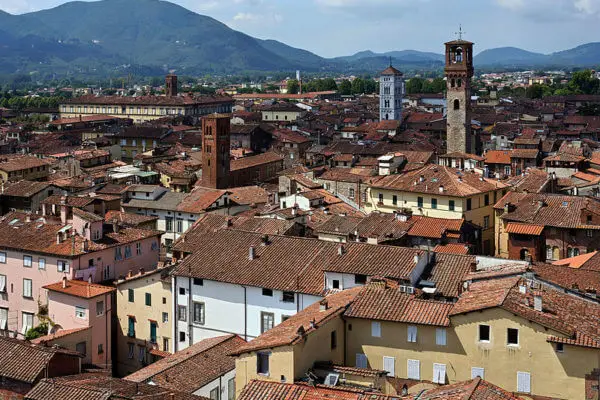Contributed by Fergus T. Maclaren: Canadian National Expert Representative, International Council on Monuments and Sites (ICOMOS) International Cultural Tourism Committee / Principal, MAC-DUFF Tourism ● Heritage ● Planning
Increased visitation to Europe’s cultural capitals, such as Florence, hasn’t come without challenges. Here’s how you can help.
Every year, the allure of incredible art, centuries-old architecture, and other historic wonders draws more and more tourists to Europe’s cultural capitals. But with this increase have also come harmful side effects and challenges for these destinations and people who live there.
The narrow streets, buildings, and monuments of historic urban cores are feeling the pressure. Long-time residents, crafts artisans and small businesses find themselves struggling to keep up with the increased cost of living. Tourism has driven up rents and taxes, and many apartments have been converted into short term rentals. In addition, the influx of visitors has made it more difficult for locals to access basic services and amenities. In many cities, this has enraged residents leading to waves of anti-tourist sentiments and protests. Destinations are challenged to find the right balance of dealing with this changing urban dynamic, while still encouraging visitors to come and experience the unique culture of their locales.
Florence is a prime example of place that has felt the strains from tourism. Founded by the Romans in 59 B.C., it’s no secret that the city is a culturally rich destination and its Historic Centre was declared a UNESCO World Heritage Site in 1982. Florence is known for its eclectic mix of Medieval, Gothic, Renaissance and Romanesque architecture. There are also a number of traditional crafts that have evolved over time including Florentine mosaics and ceramics, fashion and jewelry design, leather goods, art reproductions, shoes, gold and silversmith industries. As Tuscany’s principal city, it is also the center of the region’s renowned cuisine and wines made with traditional, fresh ingredients.

The current population of Florence is about 400,000 residents, but the city welcomes up to 4 million tourists per year on top of this. The 2 percent annual tourism growth rate is beginning to place significant demands on the city’s cultural heritage resources and infrastructure. Florence is subsequently identifying unique ways to deal with a range of issues which include the following:
Physical toll on historical sites
Like many of Europe’s cultural capitals, Florence has ‘must-see’ sites that are heavily visited. Many were not designed to deal with the thousands of tourists who trample through them every day. The daily wear and tear has caused city officials to temporarily shut down buildings for repair and restoration to deal with the influx. Take for instance the Uffizi Gallery, which houses Michelangelo’s sculpture ‘David’, one of the most famous Italian works of art. In addition to experiencing a glacial flow of visitor traffic, the museum and its artifacts were also getting steadily degraded. In 2013, it was restored and expanded to accommodate 4,000 more visitors per day and host nearly triple the number of exhibits, now protected by air treatment machines. The Uffizi’s popularity, however, still sees visitors contending with long lineups, and is using online booking to control and prioritize entries.
Inappropriate use of spaces
When large numbers of visitors engage in disrespectful or careless behavior it can impact residents’ quality of life and harm heritage sites. Examples include tourists jumping in and out of fountains, inadvertently damaging materials or monuments when trying to get that perfect ‘selfie’, overfeeding local species like pigeons and ducks, and blocking transportation routes and bridges. Some cities have gone as far as installing ‘defensive architecture’ in the form of metal knobs and roughened surfaces to prevent skateboarding and loitering around cultural heritage sites. The Mayor of Florence has chosen another weapon to deal with the deluge: water. Visitors intent on consuming paninis, gelati and caffés in front of famed churches like the Basilica of Santa Croce, where Michelangelo is buried, must now contend with wet seating. Regular spraying down of flat surfaces is also intended to ensure site cleanliness. In addition, the city recently launched #EnjoyRespectFirenze, a new awareness campaign that encourages more respectful visitor behavior through images on T-shirts, mugs, keyrings and tote bags freely distributed throughout Florence’s historic district.

More tour buses, cars and people can mean diminished air quality, controls on water use, sewage overflows and a wide range of noise pollution. Crowding can also cause significant garbage accumulation and waste that ends up tossed all over the place. To enhance the quality of life for residents in the face of these challenges, Florence’s Mayor recently initiated Project “Urban Renaissance.” This project aims to improve the local environment by expanding the multi-tiered recycling system (i.e., inorganic and organic waste), enhancing the city’s accessibility; regenerating brownfield (i.e., former industrial and contaminated) sites and promoting more ‘green’ (i.e., parks, pathways, sports fields) areas in the city.
Cultural Tourism Tips
While Florence may still be experiencing increasingly larger numbers of visitors, there are ways in which you can do your part to reduce impacts and still enjoy the wonder of the city and its surrounding region:
- Follow and participate in the #EnjoyRespectFirenze campaign to learn what it means to be a respectful tourist.
- Treat historical sites and their residents respectfully, particularly around religious structures. For example: dress modestly and don’t walk around topless, abide by ‘no photos please’ requests, keep your voice low, don’t speak on your phone inside of a church, and don’t touch artifacts or climb on monuments.
- Consider travelling during less busy times of the year, such as during the winter months, if your schedule allows for it.
- Opt to visit other nearby or regional venues, such as Lucca, Arezzo, or the Tuscany countryside, that may be less crowded, but where you can still gain a unique and less demanding local, cultural experience.

- Dispose of litter in proper receptacles and try to travel in a manner that minimizes impacts on the local community and sites. More information on waste management in Florence is available here.
- Support organizations such as the Fondazione Romualdo Del Bianco-Life Beyond Tourism, Save Florence and the Friends of Florence society that assist in preserving Florence’s cultural heritage and support sustainable development.
About ICOMOS: A global non-government organization affiliated with UNESCO, ICOMOS is dedicated to promoting the practical application of theory, methodology, and scientific techniques to the conservation,management and sustainability of cultural heritage places.
About MAC-DUFF Tourism | Heritage | Planning: MAC-DUFF Tourism | Heritage | Planning works with partners in Canada and around the globe to assess and identify what the issues are affecting destinations, how these challenges can be met, the approaches that can best support local communities and the cultural and natural resources where they live, the revenue goals of individual stakeholders, and the intents of visitors looking for a unique, memorable experience.
Free Sustainable Travel Tips List


 Written By:
Written By: 

